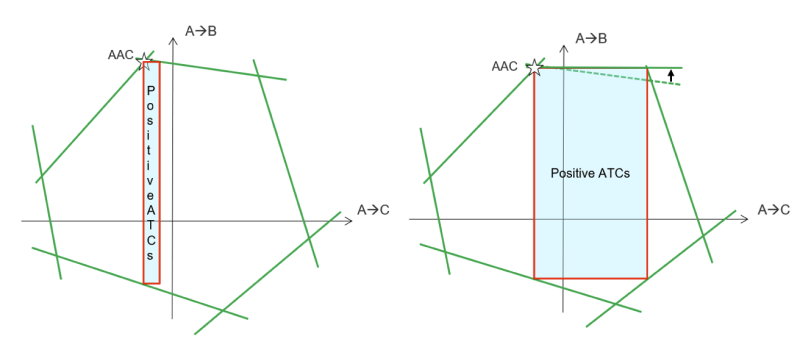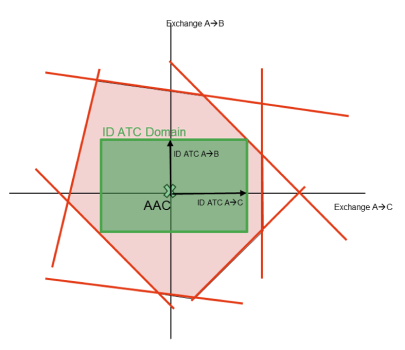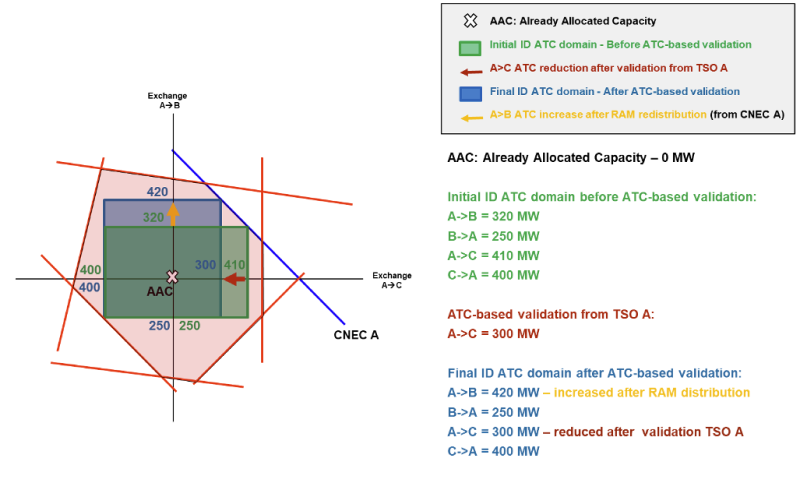Core intraday flow-based capacity calculation
Introduction to Core intraday flow-based capacity calculation
The Core intraday flow-based capacity calculation (FB IDCC) is a cooperation that provides capacities to the SIDC in Europe. The first go-live in Spring 2024 included capacity calculation processes for delivery of capacities to the market by D-1 15:00 (IDCC(a)) and D-1 22:00 (IDCC(b)). The second go-live in Spring 2025 included the IDCC(c) process for delivery of capacities to the market by D 4:30. By achieving these milestones, Core TSOs are working towards the target model for the intraday capacity calculation in the Core CCR in accordance with CACM Article 20(2). The goal of the Core FB IDCC process is to ensure an efficient allocation of cross-border transmission capacity which leads to higher integration of national electricity markets and in turn to harmonisation of the electricity price across the Core region.
Within the Core FB IDCC cooperation, a common coordinated FB capacity calculation in accordance with Article 20(2) of the CACM Regulation is implemented.
- Difference between IDCC(a) and IDCC(b-e): IDCC(a) updates the cross-zonal capacities remaining after the SDAC. There is no flow-based re-computation of capacities.
- IDCC(b-e) all consist of a FB calculation of ID capacities. The difference between the processes is the input grid model, the MTUs covered by the computation and the time of delivery of capacities to the market platform.
You can find a comprehensive overview of the differences between the IDCC processes below:
| Process name | Used grid model | Hours covered | Provision of capacities to the market | Subsequent allocation process |
|---|---|---|---|---|
| IDCC(a) | D2CF | 00-24 | D-1 15:00 | IDA1 + Continuous trade |
| IDCC(b) | DACF | 00-24 | D-1 22:00 | IDA2 + Continuous trade |
| IDCC(c) | IDCF | 06-24 | D 04:30 | Continuous trade |
| IDCC(d) | IDCF | 12-24 | D 10:00 | IDA3 + Continuous trade |
| IDCC(e) | IDCF | 18-24 | D 16:00 | Continuous trade |
On this page a description of the IDCC(a), IDCC(b) and IDCC(c) process is provided. Final details of the differences of processes (d-e) will be published towards the go-lives of the respective processes.
Core ID FB capacity calculation process explained step-by-step

Actors involved in the capacity calculation process:
- Transmission System Operators of the Core region - Core TSOs
- Regional Coordination Centers – RCCs (TSCNET, CORESO) in their role as the Coordinated Capacity Calculator – CCC
- Joint Allocation Office (JAO)
Below, a stepwise description of the Core FB ID capacity calculation process is provided.
IDCC(a)
The high-level process steps can be divided into several sub-steps, resulting in the following capacity calculation process flow for IDCC (a)
The four high level process steps can be divided into several sub-steps
Via the below interactive flow-chart, you can learn more about every step. Each step is clickable and navigates you through the process.
Step 1Input delivery
1.1DACC Data Gathering
During the DACC Data gathering phase, the DA CCCt will send the final DA FB domain, plus merged LTAs & LTNs to the ID CCCt, as input for the DA leftover extraction. Using these inputs, a DA leftover domain can be created.
1.2Calculate enlarged domain (after DACC)
Using the final DA FB Domain, the merged LTA and LT nominations and the settings for LTA and minRAM consideration, an LTA and minRAM enlarged FB domain is calculated. The process is carried out for each hour of the business day.
1.3Market Coupling Results (MCR) Data Gathering
The results of the DA Market Coupling and (if applicable) AC are gathered for the DA leftover calculation. The AAC of each border/direction are determined.
Step 2Initial ID ATC extraction
2.1Initial ID ATC extraction
The Market Coupling Mechanism for the ID timeframe is not able to accommodate FB parameters yet. In order to handle the capacity calculation results, an ID ATC/NTC extraction has to be performed.
The figures below visualise the ID ATC extraction process, considering the AAC from the MCR outputs. The AAC can be inside or outside the enlarged FB domain.

The outputs from the initial ID ATC extractions are:
- Initial Intraday NTCs
- Initial Intraday ATCs

2.2PTDF and RAM_ID threshold
For the ID ATC extraction process, TSOs implemented a method to extract the ATC domains in a more effective way by considering the impact of low zone-to-zone PTDFs of the limiting constraints. All zone-to-zone PTDFs below a defined PTDF threshold are set to zero for each ATC domain limiting constraint (CNEC) with its RAM below a threshold. This feature enables the extraction of non-zero ATCs in certain border directions which would have zero ATCs otherwise.
At the end of this step, initial ‘unvalidated’ ID NTCs/ATCs are sent to TSOs for Individual Validation. Initial Intraday NTCs and ATCs are not forwarded to the XBID platform.
Step 3Individual ATC-based capacity validation
3.1Simple Coordinated Validation RA potential & Advice
The aim of this phase is for each Core TSO to conduct an individual analysis on whether the cross-zonal capacity has the potential to breach operational security limits within its own control area. Additionally, it determines if these violations can be prevented by implementing remedial actions.
Core TSOs are allowed to perform an ATC-based Individual Validation until two years after the go-live of IDCC(a-b). In ATC-based validation, a TSO may reduce the ATC on its borders. The specific method of validation is an individual responsibility of each Core TSO. The reduced ATC value is returned to the CCCt, to be considered in the final ID ATC extraction.
Step 4Final capacity calculation process
4.1Final ID ATC extraction
The aim of this step is to extract Final ID ATCs by considering the merged ATC-based validation results. Performing a new ID ATC extraction, considering the ATC-based validation results and updated ECs, allows for a redistribution of ATCs from reduced borders to other borders. This is demonstrated in the example below. The outputs from the final ID ATC extraction are the final ID NTCs and final ID ATCs. The final ID NTCs are calculated by adding the AACs to the extracted ID ATCs.

4.2Publication
The initial and final ATCs and NTCs are published on the JAO publication tool. A full description of all publications can be found in the publication handbook which can be downloaded from the JAO publication tool.
IDCC(b-c)
The IDCC(b) and IDCC(c) processes are identical except their data input and therefore their process descriptions are combined.
Step 1Input delivery
1.1Input file delivery
To execute the Core ID FB CC (b-c) processes and obtain precise results, correct inputs are required. These inputs are mainly provided by TSOs and RCCs. After the delivery of the inputs, merging of the data takes place.
The main inputs for the ID FB capacity calculation process are:
- CNECs: Each TSO is responsible for defining its initial list of CNECs. Defined CNEs will be fully or partially located in the TSO’s own control area, and can be overhead lines, underground cables, or transformers. The defined CNEs are linked to certain contingencies. It is possible that CNECs are discarded from the capacity calculation process during the CNEC selection if they are not sufficiently sensitive for cross-border exchanges.
- CO dictionary: The CO dictionary contains all relevant contingencies considered in the CNEC lists of TSOs.
- CGM: The CGM includes all the latest forecasts for the state of the pan-European grid including expected load, renewable generation, power plant schedules, the grid topology, including outages, commercial exchanges, and foreseen remedial actions.
- AAC data gathering for ATC extraction.
- GLSK: This input defines how a change in net position is mapped to the generating units or loads within a bidding zone. Therefore, it contains the relation between the change in net position of the market area and the change in output of every generating unit/load inside the same market area.
- For the German bidding zone, the German TSOs will send individual GLSK files to the CCC tool, which are merged according to the provided pre-merge factors to a Common GLSK of Germany.
- • EC and AC: constraints that determined in a continuous process for each capacity allocation timeframe, so they are applicable for all ID CC MTUs of the respective allocation day. External constraints limit the total import and export on the Core borders of a Core or virtual bidding zone. The allocation constrains limit the global net position of the respective bidding zone.
1.2Calculate enlarged domain (after DACC)
When all the input data is collected in the CCCt, data quality checks are performed.
Results of the Data Quality Check are distributed to Core TSOs.
Based on the feedback received via the Data Quality Check, TSOs are allowed to correct and resend their input files. New data quality checks are generated after every new upload of input data.
Step 2Initial FB capacity calculation and ID ATC extraction process
2.1Initial FB computation & CNEC selection
The CCCt computes the initial FB parameters based on the merged input files. These initial FB parameters consist of the PTDF and RAM for each initial CNEC.
The initial merged CNEC list is created by merging the individual CNEC lists of all Core TSOs. CNECs with a maximum zone-to-zone PTDF less than 5% for exchanges within Core are removed according to the ID CCM. This check is performed, and fulfilment of the 5% criteria is checked separately for every timestamp of the business day. The purpose of the CNEC selection is to remove any CNEC that is not significantly impacted by cross-border trade.
2.2Initial ID ATC (NTC) extraction
The initial ID ATC extraction in the IDCC(b-c) processes are similar to the ID ATC extraction in the IDCC(a) process, as described above. However, in contrast to IDCC (a) process, negative ID ATCs can be extracted in case one or more CNECs have a negative RAM in IDCC(b-c). This is visible in the figure below.

Step 3Capacity validation process
3.1Individual validation – ATC-based
The ATC-based validation process in IDCC(b-c) is analogous to the validation process in IDCC(a), as described above.
3.2Individual validation – CNEC-based
Next to ATC-based validation, Core TSOs can perform CNEC-based individual validation in IDCC(b-c).
A Core TSO may reduce the RAM for this TSO’s own CNECs by applying IVAs. The reduced RAMs will be part of the final FB domain and used for the final ATC extraction.
Step 4Final FB computation & ATC extraction
4.1Final FB computation
The FB parameters that have been computed indicate what net positions, given the Critical Branches that are specified by the TSOs in Core, can be facilitated under ID trading without endangering the grid security.
For the final FB computation, the results of the initial FB computation are updated by the IVAs sent by TSOs to consider the outcome of the validation phase. In addition, TSOs can update the ECs for this process step.
The final FB results are shifted in a next step to the latest AAC.
4.2MC inputs gathering
The final ATC extraction is to be done based on the AAC that considers the IDA1 and continuous trade results. Therefore, the XBID platform delivers the latest AACs to the CCCt prior to the final ATC extraction.
4.3Final ATC extraction
Final ATC extraction takes place using the AAC delivered by XBID, the final FB computation results and the ATC-based validation results.
4.4Publication
The initial and final ATCs and NTCs are published on the JAO publication tool. A full description of all publications can be found in the publication handbook which can be downloaded in the JAO publication tool.
 ENTSO-E
ENTSO-E